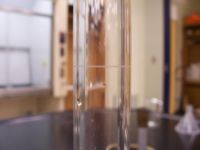Chemical glassware
This article contains a photographic list and brief description of the purpose, benefits, and problems that various pieces of laboratory glassware. The items listed here may be moved to their own separate articles at some point in the future, however, for the time being, this will do.
General
Most laboratory glassware is constructed of heat and chemical resistant Pyrex glass so that it can be used for a variety of different purposes and not pose a serious threat to contaminating the reagents held inside. Some of the glassware seen in a chemistry lab also appear in most other laboratory settings.
Beaker
The Beaker is a cylindrical glass vessel serves multiple purposes: to hold reagents during a reaction, to transport or temporarily hold a volume of substance for further use and to measure a large volume that does not require the precision of a container such as a graduated cylinder. These are typically produced from Pyrex glass to withstand heating from a bunsen burner or electric hot plate as well as being almost chemically neutral in any reaction that may take place within the confines of the container. Beakers come in many volumes ranging from a small 20mL to a large 1000mL beaker.
Test Tube
Volumetric Flask
The Volumetric Flask is used to dilute a very specific volume of a solution. Each flask is calibrated to hold a certain volume and only that certain volume. Once the reagents in the solution have been added, the flask is then filled to the calibration line, a small etching around the neck of the flask that was established when the flask was manufactured,
with the solvent and the flask shaken to ensure a homogeneous solution. Due to the specific calibration mark and a general lack of other markings, these flasks are useless in dispensing an arbitrary volume of solution and thus are only used to make solutions.


